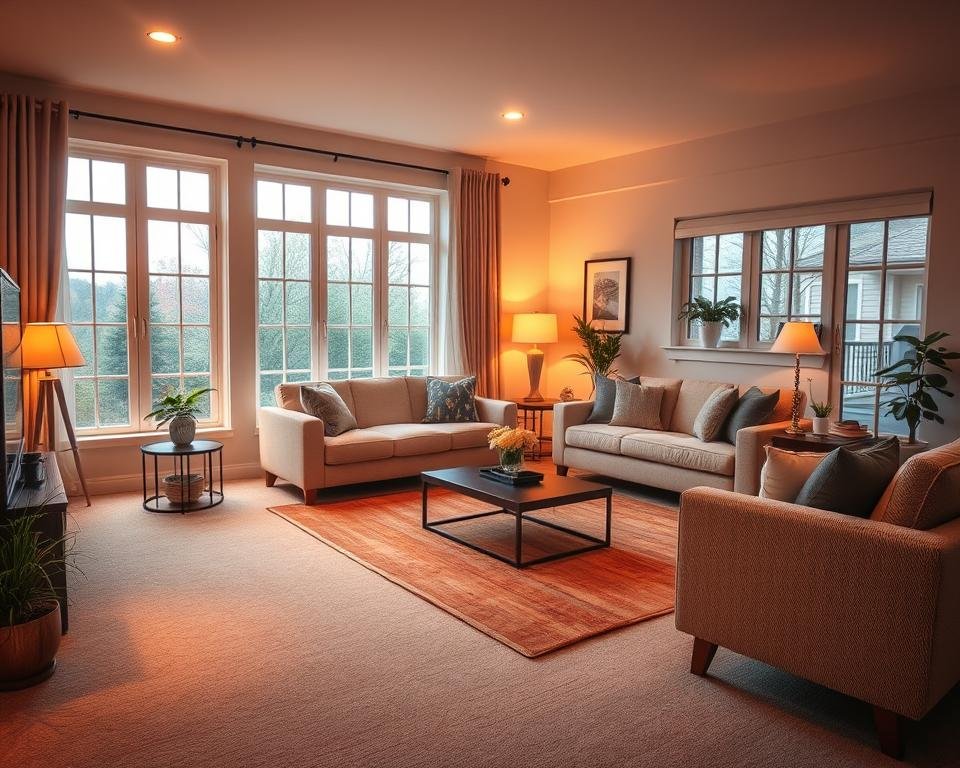“Light is the first element of design. Without it, there is no color, form, or texture.” – Helen Keller’s wisdom reminds us how illumination shapes our world. For older adults, thoughtful brightness isn’t just about aesthetics—it’s a lifeline to independence.
As we age, our eyes need more help navigating daily life. Shadows grow deeper, contrasts fade, and once-familiar spaces can become obstacle courses. But small changes to your environment make a big difference. Studies show proper brightness reduces fall risks by up to 32% while boosting confidence in daily activities.
This guide combines practical advice from occupational therapists like TPD and design experts like Vince Baiera. You’ll discover how to choose fixtures that balance warmth with clarity, where to position lamps for maximum visibility, and why dimmers matter more than you think. We’ve focused on solutions that work with your existing decor—no major renovations required.
Key Takeaways
- Optimal brightness reduces accident risks while maintaining comfort
- Layer different light sources to eliminate shadows and glare
- Motion-activated options provide nighttime safety without switches
- Warmer color temperatures enhance visibility better than harsh whites
- Regular bulb checks ensure consistent illumination levels
Let’s transform your space into one that supports your lifestyle—where every switch flip brings peace of mind. Whether you’re updating your own home or assisting a loved one, these strategies create environments that honor both safety and style.
Understanding the Importance of Proper Lighting
Navigating your home shouldn’t feel like walking through a shadowy maze. The National Institute on Aging reports that 1 in 4 adults over 65 experience falls yearly, often due to poor visibility. Brighter spaces help you spot potential hazards—like uneven floors or loose rugs—before they become dangerous.

Enhancing Visibility and Reducing Fall Risks
Dim corners and glare create tripping risks. Strategic brightness in hallways, staircases, and bathrooms makes these areas safer. For example, adding plug-in nightlights along bedroom-to-bathroom paths prevents midnight stumbles.
Research shows homes with consistent illumination see 32% fewer accidents. Motion-activated fixtures eliminate fumbling for switches. They’re especially helpful when carrying items or using mobility aids.
Impact on Mood and Independence
Good brightness does more than prevent falls—it lifts spirits. Warmer tones mimic natural daylight, reducing eye strain. This clarity lets you read labels, cook meals, and enjoy hobbies without frustration.
“A well-lit environment empowers older adults to maintain daily routines confidently,” notes a gerontology study. When you can see clearly, tasks feel manageable. That confidence keeps independence alive.
Lighting Tips for Senior Safety
Imagine your favorite reading nook bathed in soft light that lets you see every word without strain. Achieving this balance requires more than just adding lamps—it’s about matching brightness to activities and spaces.
Why Adequate Illumination Matters
Proper brightness transforms how you interact with your environment. A well-lit kitchen counter helps spot spice labels, while a dim hallway hides tripping hazards. Layer overhead fixtures with task-oriented options like under-cabinet strips to eliminate shadows where they matter most.
Energy-efficient LED bulbs offer clear advantages. They last 25x longer than traditional options while providing consistent output. Look for models with diffused coatings to soften harsh beams—especially helpful near mirrors or seating areas.
The Role of Color Temperature
Ever notice how some spaces feel clinical while others radiate warmth? That’s color temperature at work. Bulbs rated 2700K-3000K mimic sunset hues, reducing eye fatigue.
“Warmer tones improve depth perception by 18% compared to cool white alternatives,”
reveals a recent vision study.
Consider these applications:
- 3000K for bathrooms to distinguish medications
- 2700K in bedrooms for relaxing ambiance
- Adjustable bulbs in living areas for daytime tasks
Position fixtures at eye level when possible. Table lamps with upward-facing shades bounce light off ceilings, creating gentle ambient glow without direct glare.
Implementing LED, Dimmable, and Adjustable Solutions
Modern homes deserve illumination that adapts to life’s rhythms—technology meets safety in today’s best bulbs and controls. Simple upgrades like LEDs and dimmers create adaptable spaces while addressing mobility needs and reducing tripping risks.

Embracing LEDs for Long-Lasting Brilliance
LED bulbs outlast traditional options by 25 years, cutting frequent ladder climbs to replace ceiling fixtures. “Their steady glow prevents sudden brightness drops that strain aging eyes,” explains Lutron’s Director of Residential Design. Choose bulbs with 800+ lumens for task areas like countertops or reading nooks.
Utilizing Dimmers for Versatile Lighting
Dimmable switches let you adjust brightness for any activity—brighter for chopping veggies, softer for evening relaxation. Install paddle-style light switches that require minimal pressure, ideal for arthritic hands. Pair them with:
- Smart plugs for voice-controlled lamps
- Nightlight-equipped outlets in hallways
- Three-way switches at room entries
For homes prioritizing aging-in-place design, consider rocker-style panels with illuminated edges. These updates eliminate fumbling for tiny toggle switches in dark corridors, keeping focus on life’s moments—not tripping hazards.
Creating Safe Pathways and Task Lighting Areas
Clear paths and activity zones transform how you move through your home. Strategic brightness in key locations turns potential hazards into navigable spaces that support daily routines.

Smart Movement with Automatic Guidance
Motion-activated solutions like Philips Hue sensors illuminate walkways when needed most. These fixtures:
- Light up hallways 30% faster than manual switches
- Use 80% less energy than always-on nightlights
- Adapt to movement patterns over time
Install them 18-24 inches above floors near stairs or sharp turns. This placement highlights floor-level changes while avoiding glare.
Precision Brightness Where It Counts
High-activity zones demand focused task lighting. Under-cabinet strips in kitchens reveal countertop edges, while vertical sconces in bathrooms eliminate shower shadows.
Position fixtures at 45-degree angles to work surfaces. This technique reduces eye strain when reading recipes or medication labels. For added safety, choose assisted living-approved designs with non-slip bases and cool-touch housings.
These adjustments do more than prevent accidents—they create living space areas that feel intentionally designed. Well-placed brightness lets you focus on life’s moments, not potential tripping hazards.
Practical Fixture and Lamp Selections for a Comfortable Home
The right fixtures can turn harsh beams into gentle glows that protect both eyes and independence. Smart choices balance brightness with soft diffusion, creating spaces where you feel at ease during morning coffee or midnight snack runs.
Choosing Fixtures That Minimize Glare
Opaque lamp shades with diffused coatings scatter light evenly, reducing eye strain. Look for frosted glass globes or fabric-covered pendants—these soften brightness while maintaining visibility. Position fixtures at angles that avoid direct line-of-sight beams, especially near seating areas.
Optimal Lamp Types for Efficiency
LED table lamps with adjustable necks offer task-focused illumination using 75% less energy than traditional bulbs. Choose models with touch-sensitive bases—no cords to trip over. For ambient glow, try wall sconces with upward-facing designs that bounce light off ceilings.
Controls That Work With You
Voice-activated systems let you adjust brightness without reaching for switches. Install paddle-style dimmers at hip height near room entries. “These updates make spaces feel intuitive rather than intimidating,” notes a Yale housing study. Pair them with plug-in nightlights that auto-adjust based on ambient light.
Consider these combinations for common areas:
- Dimmable track lighting in kitchens
- Motion-activated closet bars
- Table lamps with built-in USB chargers
Thoughtful selections transform functional needs into design features. Your home becomes both sanctuary and safe haven—one smart fixture at a time.
Adapting Lighting for Vision Needs and Aging Well
Your eyes deserve solutions that evolve with your vision needs. Subtle changes in brightness and contrast can transform how you experience daily tasks, turning challenges into moments of clarity.
Customizing Light for Changing Eyes
As vision shifts with age, harsh overhead beams often create more problems than they solve. Layered approaches work best—combine ambient ceiling fixtures with adjustable table lamps. This strategy lets you control brightness for specific activities like reading recipes or sorting medications.
Warmer color temperatures (2700K-3000K) reduce glare while enhancing contrast. Try placing LED strips along bookshelves or stair edges. These subtle guides help distinguish objects without overwhelming sensitive eyes.
“Proper contrast ratios improve object recognition by 40% in low-vision adults,”
notes a Johns Hopkins vision study. Apply this insight by using:
- Matte finishes on walls to minimize reflections
- Nightlights with amber tones in hallways
- Under-cabinet lighting in kitchens
Smart bulbs let you save presets for different times. Morning settings might prioritize brighter task lighting, while evenings shift to softer ambient glows. Voice-controlled systems eliminate fumbling for switches during transitions.
Remember, your environment should support—not hinder—your routines. By blending practical adjustments with thoughtful design, you create spaces that care for your vision while celebrating independence.
Conclusion
Transforming your home into a safer environment starts with smart brightness choices. By combining energy-efficient LEDs, dimmable controls, and targeted task solutions, you create spaces that adapt to daily needs while reducing risks. Bedside lamps with warm-toned bulbs help navigate nighttime routines, while motion-activated hallway guides prevent missteps.
Every room benefits from layered approaches—overhead fixtures paired with adjustable accents eliminate shadows where they matter most. Strategic placement near stairs, countertops, and seating areas ensures clear visibility during critical tasks. These updates work together to build confidence in daily activities, from reading medication labels to moving through dimly lit corridors.
Consider evaluating your current setup using aging-in-place strategies that prioritize both safety and comfort. Simple swaps like installing rocker switches or adding under-cabinet strips make spaces more intuitive. Even small upgrades, like using bulbs with amber-toned nightlights, offer immediate benefits.
Your home should empower independence at every turn. With thoughtful adjustments guided by expert insights, you’ll craft environments where clarity meets calm—one smart choice at a time.
